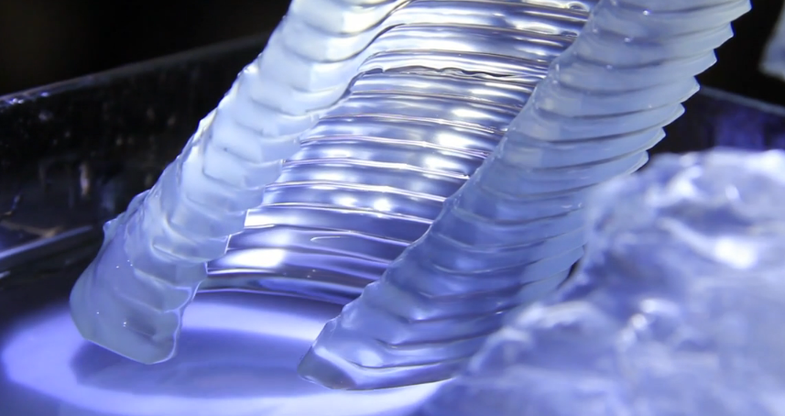A New Breed Of Robotic 3-D Printer Lets You Change Design In Mid-Print
Blending a light-sensitive resin, an ultraviolet projector, and robotics to turn 3-D printing upside down.

A husband-and-wife team has taken home the first Gehry Prize from the Southern California Institute of Architecture for exceptional thesis projects (named for the architect Frank) not for a particular architectural design but for creating a unique method of 3-D printing that allows the user to alter the design in progress, creating a physical model of streaming information.
Conventional 3-D printing generally works by precisely depositing thin layers of heated, extruded plastic or resin one atop the other based on a 3-D digital model of the desired object. Another kind of additive manufacturing, known as stereolithography, builds objects using light-sensitive resins and some kind of light source (a laser, a UV projector, etc.) that precisely cures the liquid resin into a solid (generally creating objects from the top down rather than the bottom up). Liz and Kyle von Hasseln’s project, known as Phantom Geometry, is of the latter mode, but its also executed on a huge scale. And where most printers stick firmly to a digital 3-D model of the desired object, Phantom Geometry allows the user to print outside the specifications of a given 3-D model. As a printed product emerges, the designer can alter the design in-progress, in turn altering the downstream architecture of the printed product.
The system is comprised of a UV light projector, a special photo-sensitive resin, and precision-controlled robotic arms borrowed from SCI-Arc’s Robot House. The projector is mounted on a robotic arm just below a shallow vat of resin that hardens when exposed to UV rays, much like the stuff dentists use to create molds of patients’ teeth. The projector can beam UV rays up into the bottom of the transparent vat in any shape or form the programmer desires. Layer by layer this hardens the resin, fixing each new layer to the previous one. Leftover liquid resin continues to flood into the print area to be cured with the next burst of light (this is perhaps better explained visually in the video below).
As a result, the finished product appears to be slowly extracted out of the vat, emerging as a series of eerily beautiful tendril-like structures that appear almost organic. And as with living things, the development of each object can be impacted by external influences–in this case, by a change in the stream of data inputs dictating the shape and design of each layer. In that light, you might think of Phantom Geometry as a classic case of technology and art teaming up to imitate life.
Phantom Geometry from Liz and Kyle von Hasseln on Vimeo.
[via Co.Design]